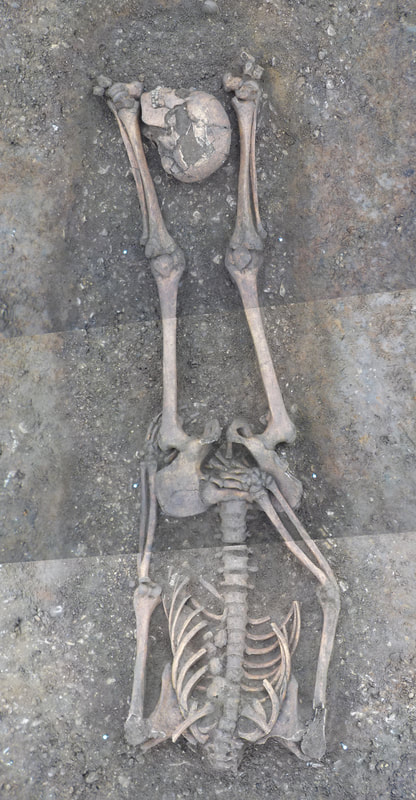|
Our recent excavations at Sedgeberrow, Worcestershire were commissioned by Orion Heritage on behalf of Kendrick Homes. We unearthed two Roman-era burials near a contemporary corn-drying kiln, within a multi-phase archaeological landscape. Works were undertaken ahead of a proposed housing development. The younger of the two males buried at the site was wearing hobnail boots and had had his severed head placed between his feet. The excavation revealed a complex series of ditches dating to the middle and late Roman period, with the earliest dated to approximately AD200-300. These formed part of a larger agricultural field system which was modified multiple times into the early 5th century AD, the very end of the Roman period. The fields would have been used to grow crops and keep animals for the Romano-British predecessors of the current Sedgeberrow inhabitants. Two limestone-built corn-drying kilns were also recorded, which provided direct evidence of late Roman crop processing on site. Harvested grain would have been placed in these structures and a small fire would be lit. The construction of the drier encouraged warm air to be drawn through, slowly drying cereals prior to storage, transportation or processing. Archaeological illustrations of the two excavated driers are presented below. Both are built to the same basic design, but 'Grain Drier 2' was slightly larger. Burned stone is marked in red on the drawing, giving an indication where the heat-sources for the kilns were situated.  The site was also used as a place to bury the dead. Two Roman inhumation burials were discovered near to one of the corn drying kilns, both were of adult males. The younger of the two, aged approximately 15-23 years old, had his skull placed between his lower legs and was buried wearing a pair of hobnail boots. No leather-work of the boots survived and we only know they were present from the remains of the nails. The reason for his skull being deliberately placed by his feet is uncertain. It’s possible he was an executed criminal and the burial was intended as punishment. Removing the head after death may alternatively have been a pagan funeral rite to release the spirit after death. Roman burials with severed heads placed at the feet are not uncommon in England, with similar examples excavated in Suffolk at Great Whelnetham & in Wiltshire at Boscombe Down. The older male, aged between 21-38 years old, exhibited evidence of infections related to joint disease which would have had a significant impact on his life. Further osteo-archaeological analysis of both skeletons is proposed, to learn more about their lives and death. Pottery recovered from the site mostly consisted of local wares and vessels imported from pottery production centres within Britain such as grey ware from Alice Holt and black burnished ware from Dorset. Two sherds of samian ware from central Gaul were the only foreign imported pottery that was discovered. Several fragments of tile from a hypocaust system were also found, suggesting that a high status Roman building might have been located nearby. Animal bones showed that there were multiple domesticated species on the site, although cows were by far the most numerous, likely used for both meat and milk.
The Romano-British field system was overlain by later activity, including a possible pit of Saxon date, a post-medieval ditch and two large quarry pits. The excavation was undertaken for Kendrick Homes by Rubicon Heritage Services Ltd as part of the Red River Archaeology Group, commissioned by Orion Heritage. Wychavon District Council was the local authority, with Aiden Smyth as archaeological advisor for the project.
0 Comments
Your comment will be posted after it is approved.
Leave a Reply. |
Categories
All
|
|
|
|
|
|
|
RED RIVER ARCHAEOLOGY
|
